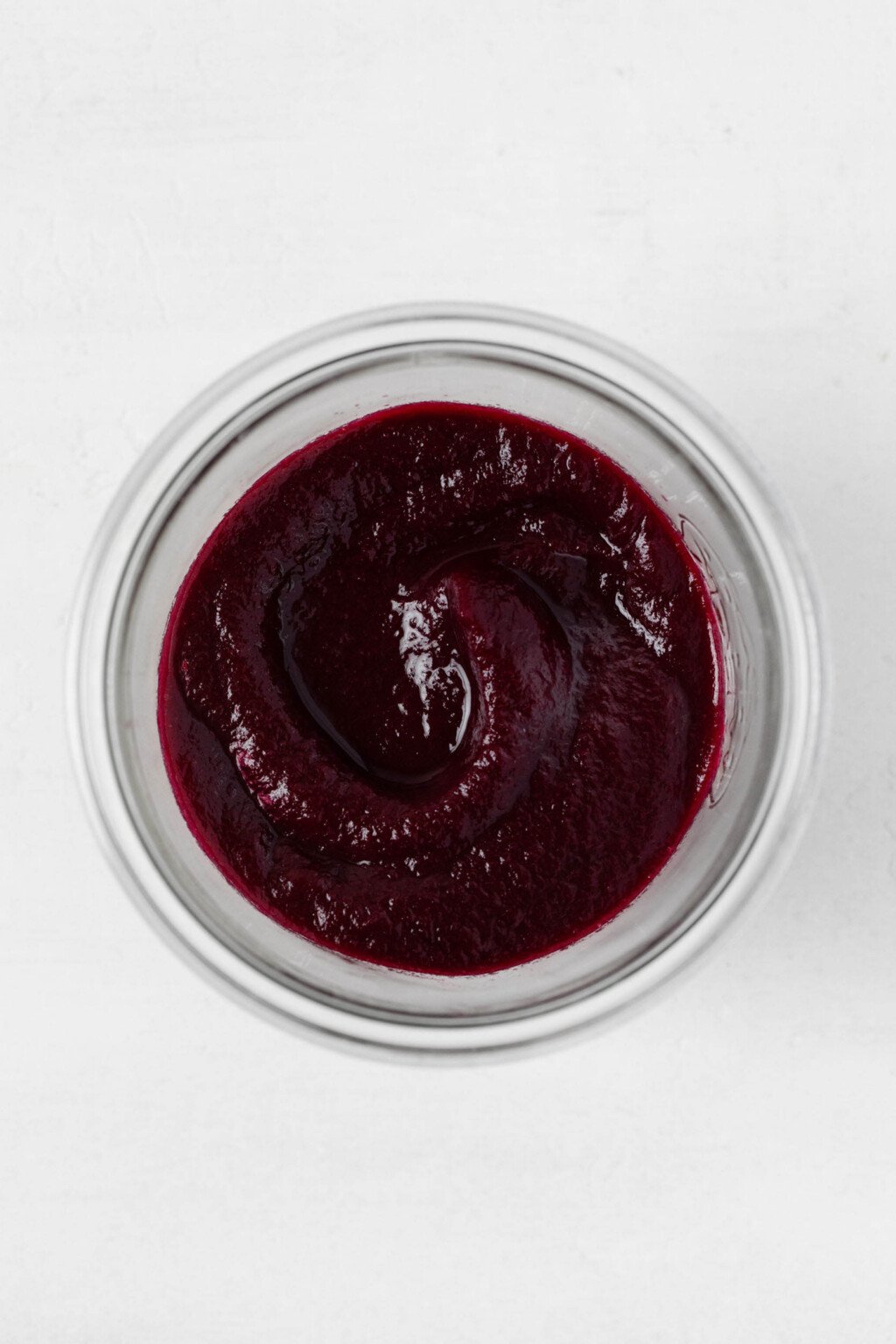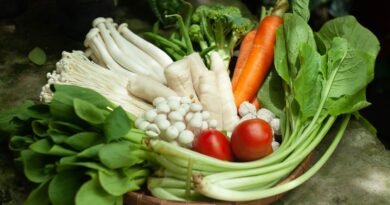Roasted Beet Ketchup by Gena Hamshaw
This roasted beet ketchup is an alternative approach to the beloved sweet, salty, and tangy condiment. In place of tomatoes, the recipe calls for oven roasted beets, and for sweetness, it uses pitted medjool dates, rather than a refined sweetener. It’s a vibrantly colorful and tasty sauce for veggie burgers, fries, and more!
Summer is the season for veggie burgers and carrot dogs, not to mention casual gatherings with finger food and snack boards.
This means it’s also a time for sauces, dips, and dressings—especially ketchup.
I’ve always really liked traditional, store-bought ketchup. But in the spirit of making homemade condiments, which has been a focus for me this year, I want to share an alternative.
I first created this beet ketchup years ago, as a dipping sauce for the baked pumpkin-seed crusted tofu that’s a meal prep favorite around here.
Over the years, I’ve made it again and again. The beet ketchup is, of course, very different from regular, tomato-based ketchup. But I just love it’s deep, dark purple color, and it’s a great thing to make when I’ve roasted a lot of beets in the oven and have a few to spare.
I also appreciate the sweet, earthy flavor of this nontraditional ketchup. As peak grilling season nears a close, I thought it would be a nice time to share it.
Why would I make ketchup with beets?
If it ain’t broke, why fix it, you might say. And there’s a lot to love about good, old-fashioned, tomato-based ketchup.
Even so, there are a few reasons why you might use roasted beets as the base instead.
Beets are beautiful
The first could be that you’ve roasted a lot of beets, maybe in order to use up a farmer’s market haul or a CSA share, and you’ve got some to spare.
Another might be that you love the great nutrition that beets have to offer.
Some nutritional highlights of this vegetable:
nitric oxide that can improve circulation and help to maintain healthy blood pressure levels
phytonutrients that are associated with lowering inflammation and protecting cardiovascular health
folate
Vitamin C
dietary fiber
Beets are really a superfood, and this is a low-key, fun way to eat more of them.
A nightshade-free ketchup
There isn’t strong research to support avoiding nightshades for arthritis and other inflammatory diseases, especially when that choice ends up making nutrient-rich vegetables off-limits. Still, some arthritis sufferers feel that the solanine in nightshades is a trigger, and they choose to avoid tomatoes, peppers, and other nightshades for this reason.
There are also some who find that tomato is a big trigger for GERD or other upper GI complaints.
For all of these folks, tomato-free and nightshade-free recipes come in handy. There are some tomato-free alternatives to marinara sauce, including beet marinara or pumpkin pasta sauce. Beet ketchup is a similar kind of swap.
Sweetened with dates
At least once each week, a nutrition client talks to me about trying to avoid the refined sugar in store-bought dressings and sauces.
Usually, I tell clients not to get overly worried about the sugar in condiments, unless they tend to have those condiments in large amounts.
When a product has a pretty small serving size—one tablespoon, in the case of ketchup—the total sugar intake won’t be huge, even if refined sugar is an ingredient.
Still, I understand that homemade condiments or sauces, like my 20-minute marinara sauce or this ketchup, give folks a chance to be especially discerning about refined sugar, if that’s their goal.
Delicious!
Finally, you might be curious about beet ketchup simply because it’s tasty and fun!
Me, I love it’s earthy, deeply sweet flavor, which is so different from the aggressively tangy quality of tomato ketchup.
Ketchup tastes unmistakably like ketchup. It’ll always be what it is. Beet ketchup tastes similar to the real deal, yet unique. In some ways, it’s less easy to typecast and more versatile.
Do I have to roast the beets from scratch?
I love the flavor of homemade roasted beets, and I think my simple oven roasted beets make the process as easy as possible. You don’t have to peel the beets before you roast them; instead, you just slip off the skins once they’re done.
Still, there are some weeks when any cooking is too much cooking. We’ve all been there.
For those weeks, I would invite and encourage you to use one of the store-bought, pre-cooked beet options. There are a few, but I like the Love Beets ready-to-eat cooked beets.
Just chop a few of these roughly, transfer them to your blender, and proceed with the recipe as it’s written.
Beet ketchup ingredients
The ingredients for this recipe are pretty simple:
apple cider vinegar
water
pitted medjool dates
salt
onion powder
garlic powder (or a small clove of garlic)
The vinegar and onion and garlic powder create some of the savory/acidic notes from traditional ketchup. Medjool dates and the beets themselves add the sweetness.
If you want to get creative here, you could add a pinch of smoked or sweet paprika, some dried herbs, or another seasoning that comes to mind.
How to make roasted beet ketchup
Step 1: Roast your beets
If you do wish to roast your beets from scratch, then that’s step 1 of the recipe.
You can find full instructions in this post.
Go ahead and make a double batch, if you love beets! Use some in the beet ketchup, then use the rest for marinated beets, quinoa beet bowls, or creamy kale and beet pasta.
Step 2: Add the roasted beets to a blender with the other ingredients
Once the beets are cool enough to peel and handle, chop them roughly. Add them to a blender, along with the remaining beet ketchup ingredients.
The roasted beets will be entirely fork-tender, which makes them easy to blend.
Add the beets to a blender, along with pitted dates, vinegar, water, and seasonings.
Step 3: Blend away
At this point, making the ketchup is as easy as blending for a couple minutes.
The finished beet ketchup will have some texture—it doesn’t get ultra creamy and smooth—but it should be relatively smooth and have a uniform consistency.
Blend the beet mixture until it’s uniform and relatively smooth.
The finished beet ketchup should have a deep, dark purple color and a consistency that is similar to traditional ketchup.
You’re aiming for something that could easily be spooned or drizzled, yet isn’t too liquidy. Add a little extra water if you need to.
Step 4: Serve or store
Beet ketchup can be stored easily. Just keep it in an airtight container in the fridge for up to six days, or freeze it for up to eight weeks.
If you don’t need to store it for a longer period of time, then you can get right down to the business of enjoying it.
A few recipes that beg for beet ketchup
Once you have a jar of the homemade ketchup in your fridge, you can start thinking about recipes that would be even better with a few spoonfuls of beet-and date-sweetened sauce on top.
Here are a few of my favorites:
Unfussy sweet potato black bean burgers
Balsamic grilled vegetable burgers
Roasted Japanese sweet potato wedges
Roasted red pepper sweet potato tortillas
And if this recipe is up your alley—or if you like to rely on pitted dates for sweetening in general—then it’s also worth checking out date BBQ sauce!
Roasted Beet Ketchup
Equipment
Ingredients
Instructions
In the next few weeks, I’ll have a recipe or two to share that would be a very good vehicle for some beet ketchup.
But in the meantime, I hope you’ll find some familiar, fun ways to enjoy it.
xo
The post Roasted Beet Ketchup appeared first on The Full Helping.
The Full Helping




